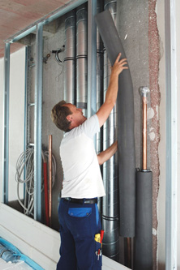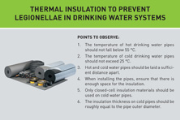Armacell insulation materials protect hot and cold water pipes against unacceptable temperature fluctuations which can occur during the summer when the risk of legionella also rises. During holiday periods water stagnates in pipework, making HVAC and plumbing systems an ideal breeding ground for hazardous bacteria.
 Armacell insulation materials protect hot and cold water pipes against unacceptable temperature fluctuations which can occur during the summer when the risk of legionella also rises. During holiday periods water stagnates in pipework, making HVAC and plumbing systems an ideal breeding ground for hazardous bacteria.
Armacell insulation materials protect hot and cold water pipes against unacceptable temperature fluctuations which can occur during the summer when the risk of legionella also rises. During holiday periods water stagnates in pipework, making HVAC and plumbing systems an ideal breeding ground for hazardous bacteria.
Legionnaires’ disease is an underreported and severe form of pneumonia transmitted by pathogens in water. There is no reliable epidemiological data for the disease in Europe, but estimates vary between 10,000 and 20,000 cases per year. Contaminated air-conditioners, swimming pools or whirlpools and cooling towers are well-known sources of infection. Errors made in the design and installation of sanitary systems can also lead to a dangerous rise in legionella in drinking water as well as fountains, sprinkler systems and humidifiers for food display cabinets. Therefore, one of the most important preventative measures is to insulate both hot and cold water pipes using suitable materials.
Legionella are bacteria which can get into the drinking water systems of large buildings such as hotels and hospitals through the central water supply. They are particularly likely to multiply in stagnant water at temperatures between 25°C and 45°C. The bacteria become hazardous when they are inhaled as small droplets (for example, as aerosols when taking a shower). People who are chronically ill or have a weak immune system are at particular risk of contracting Legionnaires’ lung disease, which may be fatal. Because the symptoms are similar to those of flu, the condition is often not diagnosed correctly, with an estimated 95 per cent of cases going unrecognised.
A combination of measures are available to prevent microbial contamination. These include a number of operational, constructional and process-related measures to avoid a harmful multiplication of legionella in drinking water and, where possible, a combination of these should be implemented. Apart from ensuring that the water circulates continuously through the pipework, it is also necessary to prevent unacceptable temperature decreases in hot water pipes and increases in cold water pipes. According to the European standard BS EN 806-2, pipes for cold drinking water should not follow the same routes or run adjacent to space heating or hot water pipes. Cold water pipes should be protected against heat gain by ensuring sufficient clearance or preferably by insulating properly. Similar requirements apply for hot water pipes to protect them against heat loss.
 When hot and cold pipes are laid in one duct or wall cavity, or wherever water is not circulated regularly, Armacell recommends using what is known as 100% insulation, i.e. an insulation thickness which roughly corresponds to the pipework outer diameter. On hot drinking water pipes this not only prevents legionella, but also protects the pipes against unnecessary energy losses. On cold water pipes the insulation provides protection against freezing in cold weather as well as providing protection against unwanted temperature rises.
When hot and cold pipes are laid in one duct or wall cavity, or wherever water is not circulated regularly, Armacell recommends using what is known as 100% insulation, i.e. an insulation thickness which roughly corresponds to the pipework outer diameter. On hot drinking water pipes this not only prevents legionella, but also protects the pipes against unnecessary energy losses. On cold water pipes the insulation provides protection against freezing in cold weather as well as providing protection against unwanted temperature rises.
Suitable insulation materials also prevent unwanted condensation. Because of the risk of condensation, only closed-cell insulation materials with a high resistance to water vapour diffusion should be used on cold drinking water pipes. In practice, accidental damage to insulation has shown that open-cell insulation materials (no matter whether with or without a vapour barrier) do not sufficiently prevent moisture ingress as a result of diffusion. With open-cell materials the resistance to water vapour diffusion is concentrated on the vapour barrier, so even if the systems are installed carefully, water ingress can often not be avoided. This means that there is a danger of water vapour in the air penetrating the insulation, condensing and saturating the insulation material. As the material becomes damp, the thermal conductivity increases and insulation properties deteriorate, causing a rise in energy losses. Furthermore, corrosion and other expensive consequential damage can occur.
 Armacell insulation materials including AF/Armaflex Class O, Armaflex Tuffcoat and Tubolit protect pipes against temperature increases and decreases. Due to their excellent technical properties, these insulation materials reliably prevent the temperature fluctuations in pipework and at the same time protect the installations against energy losses. The closed-cell material structure also prevents moisture ingress and corrosion of pipework.
Armacell insulation materials including AF/Armaflex Class O, Armaflex Tuffcoat and Tubolit protect pipes against temperature increases and decreases. Due to their excellent technical properties, these insulation materials reliably prevent the temperature fluctuations in pipework and at the same time protect the installations against energy losses. The closed-cell material structure also prevents moisture ingress and corrosion of pipework.
POINTS TO OBSERVE
- The temperature of hot drinking water pipes should not fall below 55°C.
- The temperature of cold drinking water pipes should not exceed 25°C.
- Hot and cold water pipes should be laid a sufficient distance apart to prevent temperature transfer.
- When installing pipework, ensure that there is enough space for insulation.
- Only closed-cell insulation materials should be used on cold water pipes.
- The insulation thickness on cold pipes should be roughly equal to the pipe outer diameter.